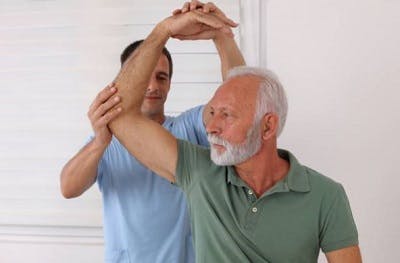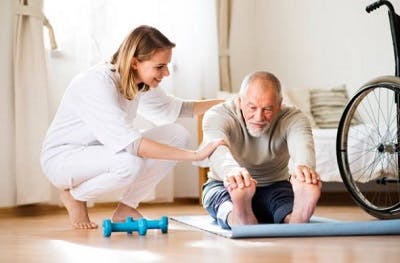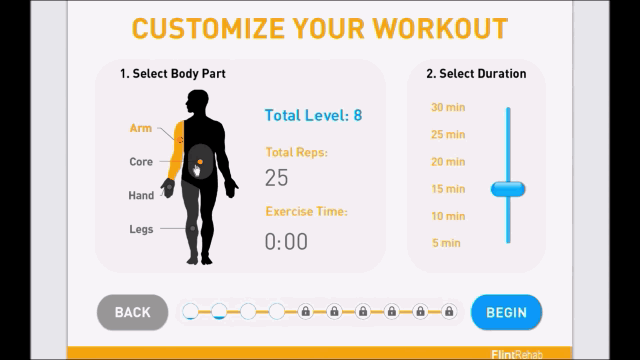No products in the cart.
No products in the cart.
No products in the cart.
No products in the cart.
Home » Neurological Recovery Blog » Spinal Cord Injury » How to Maximize Mobility with Physiotherapy for Spinal Cord Injury
Last updated on March 1, 2021

Physiotherapy for spinal cord injury rehabilitation focuses on optimizing mobility through exercise.
Because every spinal cord injury is unique, every individual requires a personalized rehabilitation plan.
A physiotherapist will assess one’s functional abilities following a spinal cord injury, create a personalized exercise regimen, and help patients work towards realistic recovery goals.
This article will go over what to expect with physiotherapy for spinal cord injury and why it’s such an essential part of the rehabilitation process.
Physiotherapy for spinal cord injury rehabilitation works because it promotes neuroplasticity.
Neuroplasticity refers to an amazing phenomenon in which the brain and spinal cord can recover from injury and regain functions that were affected by injury.
One of the best ways to promote neuroplasticity is through repetitive practice of meaningful activities, which reinforces demand for those specific functions. In turn, the repetitive stimulation promotes neuroadaptive changes in the brain and/or spinal cord.
Physiotherapy contributes to neuroplastic changes after spinal cord injuries by rehabilitating patients’ weakness and functional movements, like sitting or walking.
In rehabilitation, there are no shortcuts or gimmicks. Progress is made by focusing on regaining muscle strength and mobility using the idea of ‘use it to improve it.’
Now that you understand why physiotherapy works, let’s discuss the various exercises it can consist of.
Want 15 pages of SCI recovery exercises in PDF form? Click here to download our free SCI Rehab Exercise ebook now (link opens a pop up for uninterrupted reading)
Depending on the location and severity of the spinal cord injury, different physiotherapy exercises may be necessary.
In the following sections, we’ll review 6 different types of physiotherapy exercises that a patient might work on after spinal cord injury.

Range of motion (ROM) exercises involve moving the joints through their entire range of motion.
It’s essential to practice ROM exercises to promote circulation and prevent stiff joints.
ROM exercises can be performed passively or actively.
Passive ROM involves having a caregiver or physiotherapist move the patient’s body for them. It can even be performed on patients with complete or severe spinal cord injuries.
In contrast, active ROM exercises are performed by the patient and require effort throughout the motion. If you have enough strength in your limbs, try to perform ROM exercises on your own to stimulate and strengthen neural pathways in the spinal cord.
ROM exercises will also reintroduce movement to the body, which can help reduce pain and stiffness.
Discover passive range of motion exercises »

Many patients experience involuntary muscle contractions, known as spasticity, that results from impaired communication between the brain and muscles.
Stretching can help to lengthen painful and tight muscles and reduce pain signals within the joints.
The effects of stretching can last for hours and help prevent injuries during more strenuous exercise.
Well-stretched muscles can bear more weight and effortlessly achieve full range of motion, which makes it easier to perform any exercise.
Aerobic exercise is another important type of exercise for patients after spinal cord injury. This type of physiotherapy gets the heart pumping and boosts circulation.
Strengthening the cardiovascular system through aerobic exercise is especially important after a spinal cord injury that has affected one’s mobility. Weakened cardiac performance can slow one’s pulse and decrease blood pressure. If left unaddressed, major organ systems can start to dysfunction.
Along with strengthening the heart, aerobic exercises also help with weight regulation, which many patients may struggle with due to reduced mobility after spinal cord injury.
The following video will demonstrate some aerobic exercises a spinal cord injury patient might work on during physiotherapy.
A major outcome of spinal cord injury is reduced physical activity due to weakened motor control. This is where strengthening exercises come into play as an essential part of physiotherapy for spinal cord injury patients.
Ultimately, the lack of movement can cause your muscles to weaken and shrink in volume. This is called muscle atrophy. Individuals with muscle atrophy are susceptible to falls, fractures, poor circulation, and decreased metabolic rate.
Therefore, it’s critical to practice strengthening exercises to maintain muscle mass. Maintaining muscle mass will make it easier to perform everyday activities so that individuals can regain independence after SCI.

Patients who are further along in their physiotherapy or have mild motor impairments may work on activity-based therapy in SCI rehabilitation.
Gait training is a type of activity-based therapy that focuses on regaining walking skills after a spinal cord injury.
Through the use of walking devices, parallel bars, orthotic devices, harness systems, and technology-assisted robotics, individuals can practice shifting weight, balance skills, and advancing the lower body.
Gait training may also include getting into a pool. The buoyancy of the water will help reduce body weight and tension on the joints so that patients can participate in therapies, even with limited strength.
Activity-based therapies provide a more practical and straightforward approach to spinal cord injury rehabilitation.

The repetitions performed in a single physiotherapy session are usually not enough to promote neuroadaptive changes. Therefore, it is essential to also practice physiotherapy exercises at home.
Without a physiotherapist present, many individuals struggle with accountability. Performing the same exercises over and over can get boring and cause patients to lose motivation. This is where at-home rehab tools can help.
For example, Flint Rehab’s FitMi is a home rehab device designed to encourage users to practice physiotherapy exercises on a regular basis at home. This helps users perform the repetitions necessary to relearn functions after spinal cord injury.
Physiotherapy for spinal cord injury rehabilitation can be an extremely effective way to optimize mobility. Licensed professionals guide patients through exercises to recover as much function as possible after SCI.
Ultimately, physiotherapy is effective because it helps stimulate neural pathways in the spinal cord.
We hope this article helped you better understand how physiotherapy can play a significant role in spinal cord injury rehabilitation.
Photos from top to bottom: iStock/Antonio_Diaz/ChesiireCat/Halfpoint/kzenon

Get instant access to our free exercise ebook for SCI survivors. If you liked this post, you’ll LOVE our emails and ebook.
Each exercise features pictures of a licensed therapist to help guide you. You’ll also receive our popular recovery emails with SCI survivor stories and other useful tips — you can opt out anytime.
We will never sell your email address, and we never spam.


Flint Rehab is the leading global provider of gamified neurorehab tools. Check out our bestselling tool by clicking the button below:
Depending on the severity of your spinal cord injury, there may be hope for improved mobility. Consistent at-home therapy is key to making this happen.
That’s why Flint Rehab created FitMi, a motion-sensing, gamified home recovery tool designed for neurological injury like SCI.
Here’s what others have said about it:
“I purchased this wonderful equipment for the use of spasticity for my right hand. Initially I wasn’t sure if it would work because of the various treatments I tried and also many physiotherapists who tried their level best, but didn’t achieve any positive results.
However after trying FitMi, I could feel that slowly and steadily I am improving. It’s really a great device that minutely takes care of each and every muscle of your affected body part. The biggest plus point is, you can use this device anywhere, anytime with precise exercises that you need and also saves your money and time spent on your physiotherapist.“
— Chandrakiran
FitMi works by encouraging you to practice rehab exercises with high repetition. On average, survivors complete hundreds of repetitions per half hour session.
“Massed practice” like this helps stimulate and rewire the nervous system. While you can achieve massed practice with a written sheet of exercises, it can be tough to stick with it consistently — and consistency is key to recovery.
FitMi helps transform rehab exercises into an engaging, interactive experience. The yellow and blue “pucks” track your movement and provide feedback. All of this comes together for a motivating home therapy program.
A survivor named Tom put it perfectly:
“I believe this device will help me concentrate on making the repetitive actions needed to obtain further movement range in my wrist and hand and arm and therefore rating it with five stars. My occupational therapist recommended to give this a try. I have been using FitMi for just a few weeks. I feel more at ease in flexing.”
If you’d like to learn more about FitMi, click the button below:

Do you have this 15 pages PDF of SCI rehab exercises?
Get a free copy of our ebook Rehab Exercises for Spinal Cord Injury Recovery. Click here to get instant access.
Grab a free rehab exercise ebook!
Sign up to receive a free PDF ebook with recovery exercises for stroke, traumatic brain injury, or spinal cord injury below: